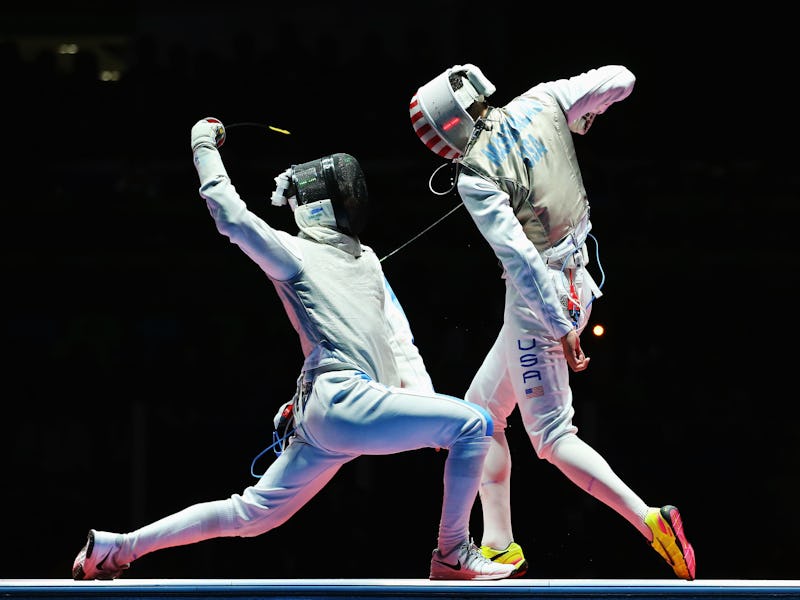You're Watching Olympic Fencing Wrong
A fencing expert tells us how to watch the Olympics' second-fastest sport like a pro.

For the first time in decades, the U.S. Olympic fencing team is in the international spotlight, thanks to the triumphant successes of foil fencer Alex Massialas, who ended Team USA’s 32-year fencing medal drought, and of saber competitor Ibtihaj Muhammad, America’s first hijab-wearing athlete. But as more fans are tuning in to the televised swashbuckling, it’s becoming painfully apparent that we have no clue what to watch for.
Hollywood’s depictions of swordfighting pirates have trained our eyes on the swish of the saber and the strike of the foil, which is believed to be the second-fastest moving object in the Olympics (after the marksman’s bullet). But if you’re sizing up America’s fencing competition with Jason Sheridan, coach and founder of New York’s Sheridan Fencing Academy, you’ll notice he’ll be watching the floor. All the real excitement, he says, happens below the waist.
“People think of fencing in the movies, as if it’s all about the swords, the clink-clink-clink-clink,” he tells Inverse. “But it’s really about the legs. It’s really about being dynamic and explosive, and surprising and fast footwork.”
By staying low and springing forward from a strong back leg, team USA's Ibtihaj Muhammad (right) maximizes speed and force.
This seems counterintuitive. Isn’t the whole point of fencing to land the end of the épée (or foil, or saber), on the lithe, uniformed body of your opponent? Sure, says Sheridan, but consider what actually drives the drama of a fencing match: No amount of swordplay is exciting unless it happens quickly — and suddenly.
No wonder, then, that fencing’s fundamental moves are designed for maximum explosiveness.
Take the en garde position, the fencer’s basic stance: Crouched low to the ground, knees bent, the fencer is “exactly like a spring,” Sheridan says. In this position, with the dominant foot in front and the other behind, a fencer is prepared to pounce forward or backward in a split second. You’ll notice they rarely move sideways — the reason fencing appears so sleek is because all of the movements are linear. At a width of only five feet, the narrow strip of floor fencers traverse, known as the piste, only accommodates the most efficient of movements.
Look even more closely, Sheridan says, and you’ll notice that fencers’ steps are quite small. When agility is paramount, the key is to keep movements small so it’s easier to change direction at any given moment. “You want to be changing your rhythm, you want to be changing your speed, changing your distance,” he says. “You want to be unpredictable.”
The ultimate success of a fencing attack relies on the mercuriality of the fencer’s movements and the speed with which it’s carried out. Again, Sheridan notes, lower body strength is key, and there’s science to corroborate this statement: One study on the kinematics of the fencing lunge, published in the Acta of Bioengineering and Biomechanics in 2013, determined that the final velocity of the sword can be predicted by the flexion of the fencer’s knees and hips, with a deeper stance producing more power during the lunge. All the while the upper body remains fairly loose: “When you do use your arm, you’re going to be free to do so without any sort of tension, anything inhibiting your ability to move it,” Sheridan notes.
With individual fencing events still underway at the Olympics, there’s still plenty of time to size up the competition like a pro. “If you watch any of the fencing at the Olympics, you’re going to see how so much of what’s going on really comes down to what they’re doing with their feet,” Sheridan says. “Not that the arms are not important — you do have to hold your weapon — but it really does come down to what they’re doing with their feet.”